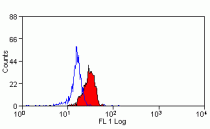ARG23646
anti-CLEC7A antibody [GE2]
anti-CLEC7A antibody [GE2] for Flow cytometry and Human
Overview
| Product Description | Mouse Monoclonal antibody [GE2] recognizes CLEC7A. This product recognizes human Dectin-1, also known as beta-glucan receptor (beta GR), a C-type lectin domain family member. It is a major pathogen pattern-recognition receptor that binds beta-glucans, glucose polymers that form cell-wall components or exopolymers of yeasts, fungi and some bacteria. Beta-glucans have also been used experimentally and therapeutically as immunomodulators that enhance resistance to bacterial, yeast, viral and protozoan infections, as well as tumor formation. Dectin-1 also acts as a co-stimulatory molecule on T-cells to induce their proliferation and is necessary for the TLR2-mediated inflammatory response. It is highly expressed on peripheral blood leukocytes and dendritic cells.Human Dectin-1 has two major (beta GR-A and beta GR-B) and several minor isoforms. beta GR-A and beta GR-B differs by the presence and absence, respectively, of a stalk region. Mouse anti Human Dectin-1 antibody, clone GE2 recognizes both major isoforms. Clone GE2 could be used to inhibit receptor function. |
|---|---|
| Tested Reactivity | Hu |
| Tested Application | FACS |
| Host | Mouse |
| Clonality | Monoclonal |
| Clone | GE2 |
| Isotype | IgG1 |
| Target Name | CLEC7A |
| Antigen Species | Human |
| Immunogen | NIH3T3 cells expressing full length CLEC7A. |
| Conjugation | Un-conjugated |
| Alternate Names | C-type lectin superfamily member 12; CD369; Dectin-1; Dendritic cell-associated C-type lectin 1; CLECSF12; CANDF4; BGR; Beta-glucan receptor; C-type lectin domain family 7 member A; DC-associated C-type lectin 1; DECTIN1 |
Application Instructions
| Application Suggestion |
|
||||
|---|---|---|---|---|---|
| Application Note | FACS: Use 10 µl of the suggested working dilution to label 10^6 cells in 100 µl. * The dilutions indicate recommended starting dilutions and the optimal dilutions or concentrations should be determined by the scientist. |
Properties
| Form | Liquid |
|---|---|
| Purification | Purification with Protein G. |
| Buffer | PBS and 0.09% Sodium azide. |
| Preservative | 0.09% Sodium azide |
| Concentration | 1 mg/ml |
| Storage Instruction | For continuous use, store undiluted antibody at 2-8°C for up to a week. For long-term storage, aliquot and store at -20°C or below. Storage in frost free freezers is not recommended. Avoid repeated freeze/thaw cycles. Suggest spin the vial prior to opening. The antibody solution should be gently mixed before use. |
| Note | For laboratory research only, not for drug, diagnostic or other use. |
Bioinformation
| Database Links |
Swiss-port # Q9BXN2 Human C-type lectin domain family 7 member A |
|---|---|
| Gene Symbol | CLEC7A |
| Gene Full Name | C-type lectin domain family 7, member A |
| Background | This gene encodes a member of the C-type lectin/C-type lectin-like domain (CTL/CTLD) superfamily. The encoded glycoprotein is a small type II membrane receptor with an extracellular C-type lectin-like domain fold and a cytoplasmic domain with an immunoreceptor tyrosine-based activation motif. It functions as a pattern-recognition receptor that recognizes a variety of beta-1,3-linked and beta-1,6-linked glucans from fungi and plants, and in this way plays a role in innate immune response. Alternate transcriptional splice variants, encoding different isoforms, have been characterized. This gene is closely linked to other CTL/CTLD superfamily members on chromosome 12p13 in the natural killer gene complex region. [provided by RefSeq, Jul 2008] |
| Function | Lectin that functions as pattern receptor specific for beta-1,3-linked and beta-1,6-linked glucans, such as cell wall constituents from pathogenic bacteria and fungi. Necessary for the TLR2-mediated inflammatory response and for TLR2-mediated activation of NF-kappa-B. Enhances cytokine production in macrophages and dendritic cells. Mediates production of reactive oxygen species in the cell. Mediates phagocytosis of C.albicans conidia. Binds T-cells in a way that does not involve their surface glycans and plays a role in T-cell activation. Stimulates T-cell proliferation (By similarity). [UniProt] |
| Calculated MW | 28 kDa |
| PTM | Phosphorylated on tyrosine residues in response to glucan binding. [UniProt] |
Images (1) Click the Picture to Zoom In






